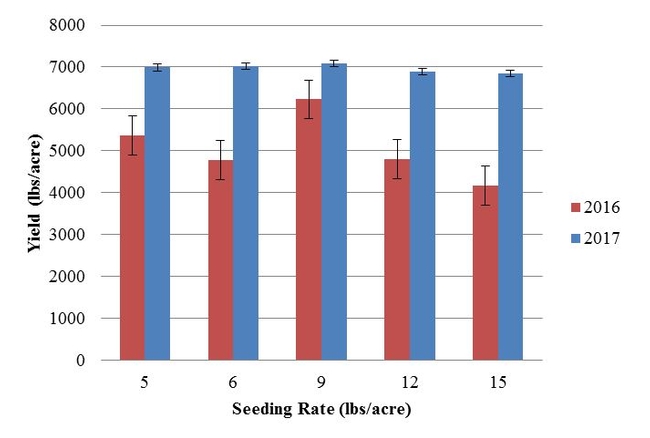In recent years, the University of California Division of Agriculture and Natural Resources has augmented research efforts on growing grain and silage sorghum [Sorghum bicolor (L.) Moench] in California. The purpose of the Delta Sorghum Seeding Rate Trial was to better understand optimal seeding rates for grain sorghum grown in the Sacramento-San Joaquin River Delta. While such information exists for Midwest sorghum production, applied information is lacking for California, and more specifically for the Delta – a unique agricultural region known for its organic soils, shallow groundwater, and cooler climate conditions. This information is important because sorghum has similar growth habits as corn and is sometimes grown as a substitute for corn because of its tolerance of drought and low-input conditions. In the United States, sorghum is used in a wide array of feedstocks for biofuels, pet foods, dairy, cattle, pork and poultry feed, and more recently as a gluten-free cereal grain for human food systems.
The trial took place during the 2016 and 2017 growing seasons on Tyler Island in Sacramento County. The 2016 trial was planted on May 20th, and the 2017 trial was planted on May 25th using a John Deere cone planter. Seed was planted approximately 2 inches deep. We used the grower's varieties, which were Eureka Seeds 3292 in 2016 and Eureka Seeds 3325W in 2017. Both varieties were white sorghum varieties, had 16,000 seeds/lb, and 85 percent germination, according to the labels. Five seeding rate treatments (5, 6, 9, 12, and 15 lbs/acre) were tested. Each plot consisted of four rows (30-inch row spacing) that were 45 feet in length in 2016 and 50 feet in length in 2017. The fields were managed similarly in both years. Site characteristics, cultural practices, and statistical procedures are described in the full report.The plots were harvested on November 14, 2016 and October 12, 2017 using an Almaco research combine, harvesting the center two rows from the four-row plots. Trial results are presented as plant establishment characteristics (Table 1), plant maturity characteristics (tables available in the full report), and yield (Figure 1). The tables and figure present mean values for the four (2016) or five (2017) replicates. Differences among treatments are indicated by different letters following the mean.
The seeding rates are expressed as plant populations in Table 1. The number of sorghum seeds/lb is highly variable across varieties. For this reason, when determining seeding rates, growers should first determine their desired plant population. A worksheet in the full report provides equations for calculating seeding rate based on desired plant populations and percent germination for the variety. Stand counts were made as the number of plants/10-foot row length approximately two weeks and one month after planting. The counts were scaled up to plants/acre. Across both years, stands generally decreased from the first count date to the second. Stand counts were lower in 2017 compared to 2016, but this did not translate into lower yields. Weeds were also counted in the month after planting (data not shown), but overall weed pressure was very low in both years.
Table 1. Plant establishment characteristics of the 2016 and 2017 UCCE Delta sorghum seeding rate trial.
While there were no statistical differences in yield across treatments in either year, the take-home message of the trial is that there appears to be no benefit to planting the highest seeding rates. In both years, the trend was for the 15-lb seeding rate to have the lowest yield. In 2016, there was a lot of variability in the data. There was a trend for the 9-lb treatment to have higher yields; however, we suspect this was due to the experimental design. In 2016, by random chance, there were several 9-lb treatment plots next to the sub-irrigation ditches, which were exterior to the experiment on both sides. For this reason, the 9-lb treatment may have been inadvertently favored with better moisture conditions. To correct for this, the experimental design was changed in 2017 in order to better control field variability. The 2017 yields were consistent across treatments, around 7000 lbs/acre. The 2017 results best illustrate how planting the higher seeding rates provided no yield benefit, yet would incur a higher seed expense. We recognize that growers will need to consider site characteristics, like weed or wireworm pest pressure, when determining optimal seeding rates; nevertheless, this research indicates that good yields can result from seeding rates of 5 or 6 lbs/acre (estimated plant populations of 80-96,000 plants/acre), and that planting higher plant populations would not only cost growers more in seed expense but could also cost them in yield.
Figure 1. Yield at 13 percent moisture of UCCE Delta sorghum seeding rate trial. There were no significant differences among treatments in 2016 (P = 0.1278) or 2017 (P = 0.2419).
In summary, it is important to study sorghum cultural practices in the Sacramento-San Joaquin Delta region, and in California at-large, because currently, most applied information comes from the Midwest. California growers need information on sorghum cultivation because sorghum may be grown as a lower-input substitute for corn. Sorghum seeding rates were studied to assist growers with determining optimum rates for the Delta environment. The results indicate that there is no yield benefit to planting seeding rates greater than 6 lbs/acre (estimated plant population greater than 96,000 plants/acre), and that planting higher rates is just added expense for the grower. Future research should investigate these plant populations on narrower row spacing. Special thanks go to growers, Steve and Gary Mello, and to UC Kearney Research and Extension Center Director, Jeff Dahlberg, for providing equipment and information for the success the trial.

